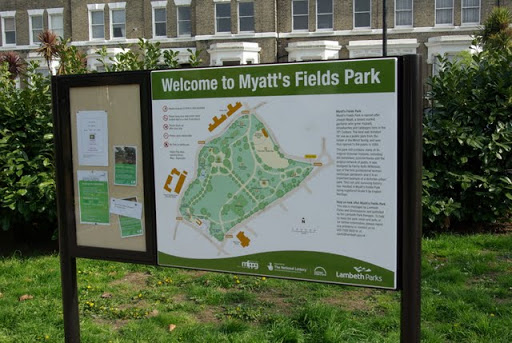Lambeth Food Partnership
Lambeth has a vibrant local food scene; it has its own Food Partnership which launched in May 2013, and brings together residents, community organisations, businesses, local government and the NHS, which has developed its own food strategy. In 2010, 170 community gardens were recorded by Capital Growth (London’s Food Growing Network: www.capitalgrowth.org). The Lambeth Food Partner-ship is a membership organisation open to anyone who lives or works in Lambeth and cares about improving food in the borough.
- Inner London Borough
- Population: 303,086
- Size: 2,682 hectares, 3 miles wide, 7 miles long
- Population density: 113 people per ha
- 39% White British (2011 Census); around 150 different languages spoken
- Transition Town Brixton’s Future of our Food event in 2009 estimated that 30% of fruit and veg demand could be grown locally if all appropriate spaces were optimised

Community Food Growing Hubs in Lambeth (LAS)
The borough of Lambeth currently has four community food growing hubs situated in different areas around the borough.
- Myatt’s Fields Park is a 5.7 hectare (14 acre) Victorian park, which underwent renovation in 2010, improving the area’s reputation. The community (via the charity Myatt’s Fields Park Project) uses the greenhouse in the park to grow a variety of fruit and vegetables, and use this for cooking projects and to supply the café at the park. Ten local community food-growing groups are supported by Myatt’s Fields Park via a community grower. The greenhouse is used to grow seedlings for the community groups for example, and there are also other resources stored at the park to support the community groups. The community grower based at the greenhouse also visits the community groups at their sites to assist them with growing by providing practical advice and support. The aim of the project is to improve people’s access to high quality, affordable and locally grown food and to celebrate local food cultures. Myatt’s Fields Park Project also runs a number of other community based food and non-food projects aimed at community development.
- Brockwell Park Community Greenhouses is a space comprising two commercial sized greenhouses as well as outside space for herb, medicinal, dye, vegetable, fruit and forest gardens, used by the local community. Twenty years ago this space was a disused municipal plant nursery, which is now managed by volunteers and part time staff. The aim of the project is to offer the local community and visitors a relaxed and tranquil environment where they can learn about the environment, wildlife and ornamental and crop plants from around the world.
- Rosendale Allotments is an allotment association, which has a diverse membership. The allotments have been managed as an association since 1921 and occupy a 7.3 hectare (18 acre) sloping site. Some of the food grown is sold in the community building, which also holds meetings, workshops and courses. Currently a voluntary committee manages the allotments, staff was previously employed. The project aims to use the expertise and experience of members to develop information, advice and workshops on horticulture in its widest sense and to broaden the interest in and commitment to sustainable food growing in the local community.
- Streatham Common Community Garden is a historic walled garden. Formally it was a kitchen garden of the Rookery (the last manor house that stood at the top of the hill, built in 1786), later the garden was also used a Council nursery, supplying plants for parks and green spaces across Lambeth, before falling in to a state of neglect. In June 2011, the garden committee worked with hundreds of volunteers to bring the old walled nursery back to productive use, continuing a history of gardening on the site going back at least 230 years. The project has a number of aims around restoration, being a community resource, protecting wildlife and improving biodiversity, to provide training around organic growing and to support other community groups, and to be welcoming to all.
Further info and pictures:
www.incredibleediblelambeth.org/myatts-fields-park-greenhouse-project
www.incredibleediblelambeth.org/brockwell-park-community-greenhouses
www.incredibleediblelambeth.org/growing-rosendale
www.incredibleediblelambeth.org/streatham-common-community-garden

Lambeth Poly: community food growing on housing estates (LAS)
Lambeth Poly was a prototype project to explore what can be grown and marketed in Lambeth, and how growing can be used to train and employ local people. The protected environment of a polytunnel can increase productivity and extend the period in which fresh vegetables can be produced in the city. The polytunnel project was proposed by local horticulturist, trainer and Garden Organic Master Gardener Fiona Law. The Innovation Fund paid for time to develop, implement and coordinate the project and some of the start-up running costs. The company Veolia sponsored the tunnel and the materials.
The tunnel is un-heated and was erected in July 2012. It is a 27.5 m2 (5 x 5.5m or 16 x 18 foot) steel tunnel covered with polyethylene foil. It is sited on Tulse Hill Estate, Brixton (Lambeth, London) on a green in the middle of a public housing estate. Since construction in July 2012 local volunteers have been trained and inducted in growing in the tunnel and several other ‘ambassadors’ from the estate are active.

Baby leaf vegetables and salads and herb pots are sold to local restaurants in Brixton (e.g. Cornercopia) using the local Brixton currency the Brixton-Pound (£B) and to the local vegetable box scheme Local Greens and, to a small extent, residents. In addition, workshop events have been held and volunteers on the project have had three wider learning opportunities. And the project won the Capital Growth’s Enterprise award in its Olympic year Grow for Gold competition. The business plan focused initially on the crop production or financial side of the enterprise producing a plan for a financially viable horticultural enterprise with commercial labour rates and professional marketing. As the aim of Lambeth Poly is a social enterprise, the financial return on investment will always be only one part of the output mix.
Fixed assets
Polytunnel 5 x 5.5m (16 x 18 ft) = 27.50 m2 tunnel sited on Tulse Hill Estate, Brixton, on a green in the middle of public housing estate. Lambeth Poly has run this tunnel since July 2012.
Machinery and tools: growing benches, black mulch, wooden seed dippers, plastic trays, watering cans
Variable assets
Compost - currently bought in as peat-free organic bags 20 kg New Horizon Seed and Growing (includes blood and bone meal hence not a vegan product) and reused 2-3 times. This is a major cost input and more recycling and using own garden and or food/kitchen waste compost would be a major step to reduce inputs, costs and increase recycling (short to medium term action).
Seeds - currently bought in from seed merchants as organic or non-organic seed. Own seed production is possible once the enterprise has 5 or more tunnels. Then one can be dedicated to seed production including heritage seed varieties. Seed production is expensive however it adds another level of skill for the training and workers and not all seeds have to home produced (medium to long term action)
Irrigation water - currently using tap water. Rainwater harvesting and other grey water use would reduce costs and increase recycling (short to medium term action).
Labour and skills – the main labour tasks are preparing planting trays by filling in with compost, planting seeds with wooden dipper, managing cropping and irrigation of seeds during growing phase, harvest of seeds, cutting plants, packing in bags, labelling, cleaning trays for next batch. Transport to customer locally currently by car ideally with bicycle trailer or electric vehicle (Short to medium term action compost preparation and rainwater collection).
Outputs
The following commodities are produced or could be produced within the business model of Lambeth Poly
- Vegetables like tomatoes and chillies, squashes or beans
- Fruit like apple and soft fruit
- Salad leafs like Swiss chard
- Herbs like basil
- Exotic vegetables like mizuma and others
Currently the following crops are produced at Lambeth Poly:
- Swiss Chard red, Mizuma Red Baron, Oriental Mizuma
- Mustard Red Giant, Mustard Pizzo
- Wild Rocket, Perilla/Shiso Green
- Oak Leaf Lettuce, Radish
- Spring Onion, Basil Puck, Red Pac Choi Rubi-F1
- Giant Sunflower, Squashes, Beans
Recent developments
In October 2013 the Lambeth Poly brand came to an end and the results are documented at http://vivekagardens.com/lambeth-poly-community-croppinghttp://vivekagardens.com/lambeth-poly-community-cropping. One of the main drivers, Fiona Law, left Lambeth and the project is now continuing as part of Lambeth Living’s programme of community food growing on estates (www.lambethliving.org.uk).
Further info and pictures: http://vivekagardens.com/lambeth-poly-community-cropping

